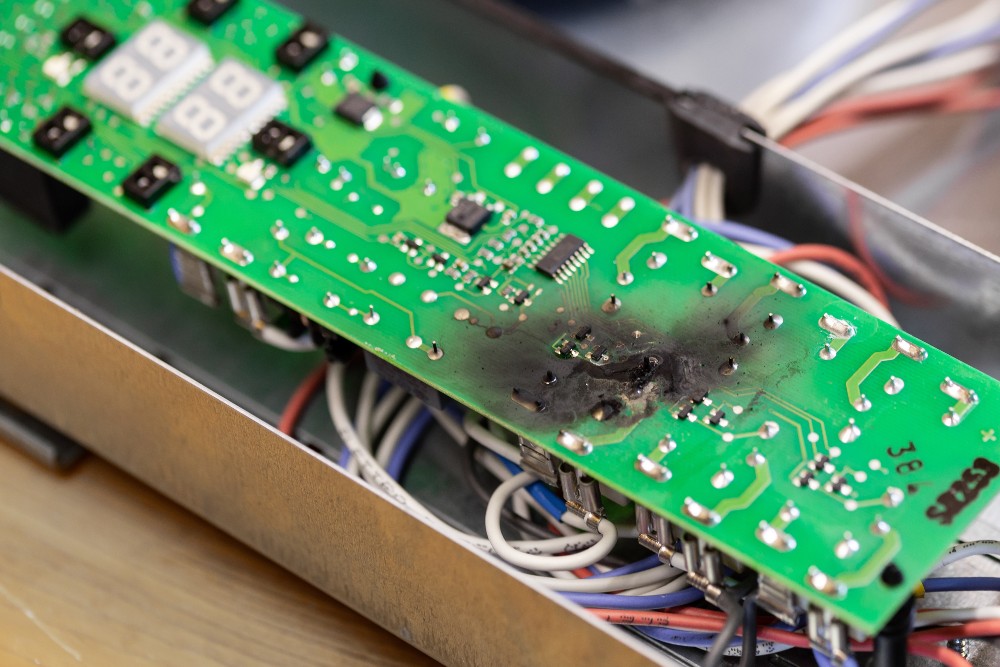Moisture exposure has one of the most harmful effects on printed circuit boards.
Even the smallest droplet can cause warping, rust, and malfunction.
Keeping humidity and moisture at bay when creating, storing, and shipping electronics and PCBs is crucial to ensure your boards and components function correctly.
There are many methods to leverage during the fabrication, assembly, storage, and packing processes to help combat moisture exposure.
First, let’s figure out exactly what happens when moisture gets into your PCB.
Effects of Moisture on PCBs
Moisture is defined as “water or other liquid diffused in a small quantity as vapor, within a solid, or condensed on a surface.”
Every location has at least some level of humidity, whether you feel it or not.
When an environment is high in humidity, more condensation accumulates, especially on cold surfaces.
The most common issue with water damage on PCBs is the circuits shorting out.
Electrical currents travel along circuits and naturally take the path of least resistance. When you add a new route to the existing path — like a water droplet — the current doesn’t know where to go, which results in a short.
If you’ve ever spilled water on a phone or laptop, or seen someone do so in a movie, you’ve likely witnessed the effects of short-circuiting from water damage.
Shorts can even create sparks, which can be highly dangerous in certain environments. But of course, the end result is what we’re focusing on — how it affects your board.
Water acts as a superconductor, overstimulating your printed circuit board and causing it to fry the system.
Another effect of moisture on your electronics is corrosion.
Corrosion occurs when a material that is exposed to water or moisture becomes weak and fragile and eventually breaks off. In the case of printed circuit boards, water can cause the components to disintegrate naturally over time and ruin the board’s functionality.
Corrosion is sorted into multiple categories:
- Fretting is when a plated switch that has been soldered becomes closed. When the plated switch is closed, this causes the oxide layer to come off easily when friction is applied.
- Electrolytic filamentation happens when water containing dissolved electrolytes gets on metal. When this happens, dendrite structures begin to grow on the surface as an electric current flows through the solution.
- Galvanic corrosion happens between dissimilar metals when dissolved salt is present. This occurs whether an electric current is present or not.
- Atmospheric corrosion occurs when metal is exposed to moisture. When this happens, the ion bonds with oxygen atoms and forms an oxide. These oxides are insulators, increasing the resistance of the exposed conductor.
How To Prevent Humidity During Fabrication
There are a few precautions you can take to help fight moisture during the PCB fabrication process.
First, make sure to laminate your PCB in a controlled environment using a humidifier. Any personnel that comes into contact with the board should be dressed appropriately in a bunny suit and gloves.
Absorb moisture in the air by using desiccant drying agents.
If your printed circuit board’s materials and components are coming into your facility from an uncontrolled environment, thoroughly wipe them down before fitting them on your board. Doing so will ensure no contaminants transfer to the PCB.
During fabrication, use meshed copper planes. Meshed planes will create a stronger bond between the layers of your PCB and reduce moisture.
Avoiding PCB Moisture During Assembly
To avoid moisture during the PCB assembly process, try baking your boards.
Baking is a common method to remove moisture.
However, applying high temperatures during the baking process can remove the lamination adhesive and cause boards to crack. To avoid this, make sure to use the baking method with caution.
Specific coatings will also help fight humidity and moisture effects in the printed circuit board assembly process.
- Conformal coating is the most efficient way to prevent moisture from accumulating on PCBs. This coating helps protect your PCB from ultraviolet light and contaminants.
- Thermoplastic overmolding can also be used to protect boards. Be sure to keep connectors exposed so that the components can connect to other boards and devices.
- Microencapsulation is when the board is partially covered with epoxy or microencapsulated. This means only certain parts of the components are covered.
- Potting encloses the PCB, repelling moisture. However, this can also trap moisture inside, so make sure the PCB is moisture-free prior to potting.
Packing and Storage Methods To Keep Your PCB Dry
When printed circuit boards aren’t packed, stored, and transported correctly, there is a high probability they’ll accrue moisture.
The last step to ensure that your PCBs stay protected is to use silica gel bags.
Silica gel bags absorb moisture and contain it. You’ll find these packets in many shipping packages — from clothes and shoes to electronics and medications.
Keep in mind that these bags are only effective for products stored under 60°C. If the temperature rises above 60°C, the absorbent gel melts and causes water to leak, ultimately destroying your boards. Ensure that PCB packaging never reaches temperatures that would cause this to happen.
You can also use moisture barrier bags to block out humidity completely.
Avoid Water Damage To Your PCBs
Combating the effects of moisture and humidity on your printed circuit boards is crucial.
You can protect against the buildup of moisture on PCBs by leveraging these solutions during the fabrication, assembly, packing, and storage processes.
To learn more about the chemicals used in the PCB manufacturing process and how to properly clean and prep boards, check out these helpful tips.

